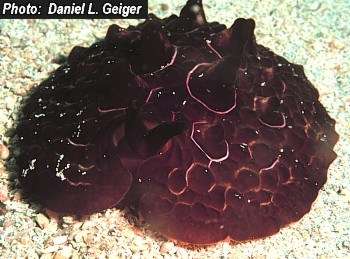
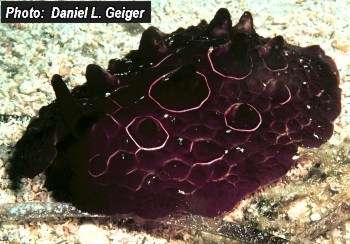
Pleurobranchus testudinarius
Cantraine, 1835
Order: NOTASPIDEA
Superfamily: PLEUROBRANCHOIDEA
Family: Pleurobranchidae
PHOTO
Baleares, Menorca, Illa d'en Colom, 8 metres, on sand near Posidonia meadow, August 1989. PHOTOS: Daniel Geiger.
Large brown pleurobranch with elongate tubercles projecting on dorsum. Pattern of polygonal rings on dorsum either white or pink.
References:
•Cattaneo-Vietti, R. (1986) On Pleurobranchomorpha from Italian Seas (Mollusca: Opisthobranchia). The Veliger, 28(3): 302-309.
•Rudman, W.B. (1993) Case 2838. Pleurobranchus forskalii Ruppell & Leuckart, [1828] and P.testudinarius Cantraine, 1835 (Mollusca, Gastropoda): proposed conservation of the specific names. Bulletin of Zoological Nomenclature, 50(1): 16-19.
•ICZN Opinion 1767 (1993) Pleurobranchus forskalii Ruppell & Leuckart, [1828] and P.testudinarius Cantraine, 1835 (Mollusca, Gastropoda): specific names conserved. Bulletin of Zoological Nomenclature, 51(2): 164-165.
Rudman, W.B., 1999 (September 16) Pleurobranchus testudinarius Cantraine, 1835. [In] Sea Slug Forum. Australian Museum, Sydney. Available from http://www.seaslugforum.net/find/pleutest
Related messages
Re: Pleurobranchus from the French Mediterranean
July 14, 2008
From: Dominique Horst
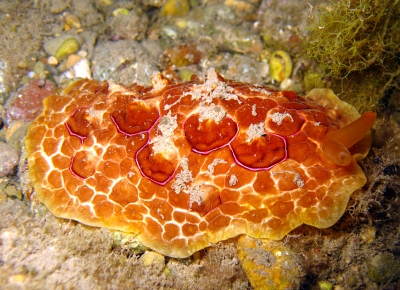

Concerning message #21071:
Hello Bill,
Still at the same site, we've met a specimen of Pleurobranchus testudinarius. It seems that this species has strong colour variation. Is it accordingly to their food variation? I wonder what can be the significance of the name testudinarius? Have you an idea about the name root ?
Locality: Cagnes, 8 m, France, Mediterranean sea, 09 July 2008, muddy. Length: 200 mm. Photographer: Dominique Horst.
Many thanks in advance,
Kind regards,
Dom.
dominique.horst@wanadoo.fr
Horst, D., 2008 (Jul 14) Re: Pleurobranchus from the French Mediterranean. [Message in] Sea Slug Forum. Australian Museum, Sydney. Available from http://www.seaslugforum.net/find/21698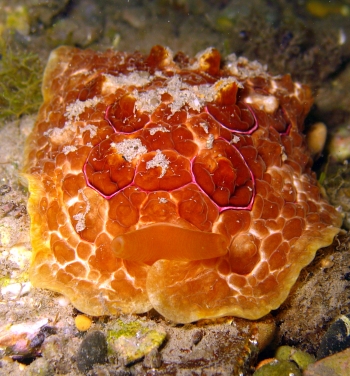
Dear Dom,
Many species of Pleurobranchus show quite a variation in background colour, from pale yellow to dark brown and even reddish purple. I don't know of any work that has been done on colour variability. More importantly we have very little information on what any species of Pleurobranchus feeds on. There are a few records of species feeding on ascidians but not enough to even hazard a guess as to whether body colour is relted to food colour.
I can help you with the origin of testudinarius. I am not a Latin scholar but I remember once reading that Roman soldiers had a defensive formation in which they all got into a tight group and the soldiers in the middle held their shields above their heads and the one around the edge held their shields out sideways so they were all protected from their enemies' arrows, spears and swords. They looked like a tortoise which in latin was testudo - which was also the name given to the defensive formation. If you look at your Pleurobranchus photos you can see the 'shields', outlined in pink, and imagine the Roman soldiers underneath.
Best wishes,
Bill Rudman
Pleurobranchus from Cyclades, Aegean Sea
November 13, 2007
From: Manolis Mpardanis
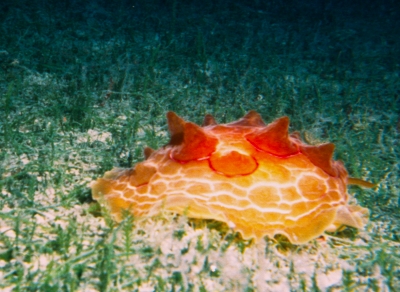
I saw two specimens of Pleurobranchus at Panormos, Naxos Island, Aegean Sea in July 2005.
Other encounters I have recorded for the same species in the same area include August 2004 at 35 m (two specimens mating, colours rather yellowish) and July 2006 at 8 m (one specimen, yellowish-green in colour with clear white rings around the tubercules).
Locality: Naxos Island, 50m, Greece, Aegean Sea, Mediterranean, 11 July 2005, Muddy with Caulerpa racemosa. Length: 20-22 cm. Photographer: Manolis Mpardanis.
Is this indeed the typical mediterranean species Pleurobranchus testudinarius? Do you believe there is any chance it could be feeding on Caulerpa racemosa or is this just a random stroll on the sea bottom?
Thank you in advance.
Manolis Mpardanis.
info@naxosdiving.com
Mpardanis, M., 2007 (Nov 13) Pleurobranchus from Cyclades, Aegean Sea. [Message in] Sea Slug Forum. Australian Museum, Sydney. Available from http://www.seaslugforum.net/find/21071Dear Manolis,
Yes this is Pleurobranchus testudinarius. The rings around the base of the tubercles varies from pink to white. All pleurobranchs are carnivorous so it would mean a major change in its physiology for it to be able to eat and digest plant material. As you suggest, its walk across the Caulerpa beds is just a random stroll.
Best wishes,
Bill Rudman
Pleurobranchus testudinarius from the Aegean Sea
September 18, 2007
From: Dimitris Poursanidis
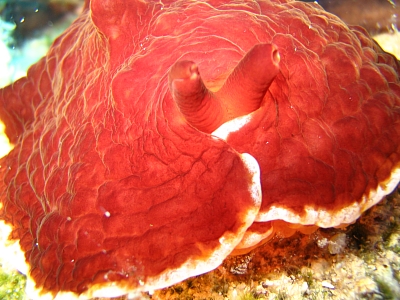

These photos where taken at Lesvos island, in the northeastern Aegean Sea, 3 years ago.
I am not sure what species of Pleurobranchus it is but maybe it is P. forskalii...
Some help on this????
Locality: Lesvos Is, NE Aegean Sea, maybe 10 to 20 m, Greece, 10 January 2004, rocky. Length: ???. Photographer: George Filios.
George Filios
dpoursanidis@gmail.com
Poursanidis, D., 2007 (Sep 18) Pleurobranchus testudinarius from the Aegean Sea. [Message in] Sea Slug Forum. Australian Museum, Sydney. Available from http://www.seaslugforum.net/find/20746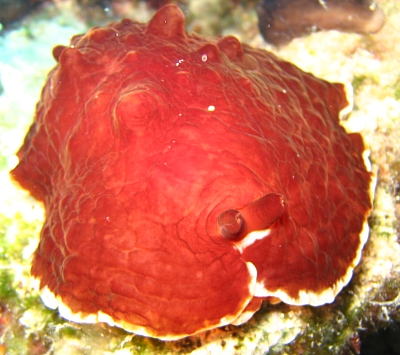
Dear Dimitris,
The high tubercles suggest that it is P. testudinarius, and I have ringed one tubercle which has part of the characteristic bluish-pinkish ring often found around the base in this species.
This dark reddish colour form with a white margin around the mantle edge does not seem to be a very common colour form but in one of Baki Yokes' photos from nearby Turkey [message #7200] there is an animal with a more usual colour pattern but with a white mantle border
Best wishes,
Bill Rudman
Pleurobranchus testudinarius? from Brazil
April 11, 2005
From: Armando de Luca Jr

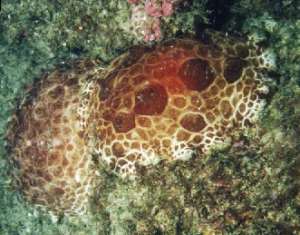
Dear Bill,
I've photos of Pleurobranchus areolatus from three islands (Alcatrazes; Laje de Santos; Queimada Grande) of Sao Paulo State, Brazil. The specimens was 20cm to 25cm and the depth was 20m to 25m. Frequently in couples.
Locality: Laje de Santos Marine State Park, Sao Paulo, Brazil. Atlantic Ocean. Depth: 25 m. Length: 250 mm. June 2004. sand and rocky bottom. Photographer: Armando de Luca Jr.
Armando de Luca Jr
mergulho@nautilusdive.com.br
de Luca, A, 2005 (Apr 11) Pleurobranchus testudinarius? from Brazil. [Message in] Sea Slug Forum. Australian Museum, Sydney. Available from http://www.seaslugforum.net/find/13454Dear Armando,
This is a very interesting find. I think your animals are not P. areolatus but rather Pleurobranchus testudinarius. This species is quite common in the Mediterranean, but to my knowledge the only record of it in the Western Atlantic is of one preserved animal from Maranhao in northern Brazil (Marcus, 1970). In an earlier message to the Forum [#2493], it is reported from Florida, but no photo was available.
If we can confirm your identification, then it is possibly a natural distribution as there are quite a number of opisthobranchs which are found on both sides of the Atlantic, though it is strange that such a big animal has not been reported before. The scattered large, nipple-like papillae are characteristic of the species.
- Marcus, Ev. (1970) Opisthobranchs of Northern Brazil. Bulletin of Marine Science, 20(4): 922-951
Best wishes,
Bill Rudman
Pleurobranchus testudinarius eggs
October 7, 2002
From: Erwin Köhler
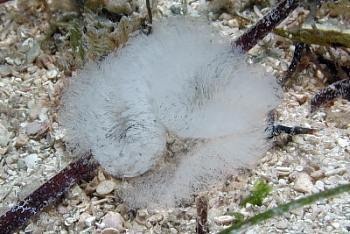
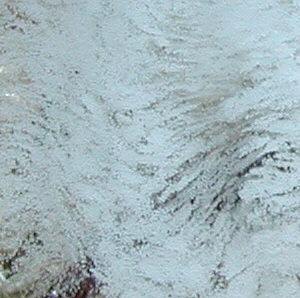
Dear Bill,
attached are 2 shots of the egg-mass of Pleurobranchus testudinarius (as I guess) from my recent trip to Kas, Turkey. I found several specimens, 2 of them mating.
Size: approx. 5 cm
depth: 12 m,
date: 15 Sept. 2002
divesite: "Oasis"
Erwin
Erwin@medslugs.de
Köhler , E., 2002 (Oct 7) Pleurobranchus testudinarius eggs. [Message in] Sea Slug Forum. Australian Museum, Sydney. Available from http://www.seaslugforum.net/find/8120Thanks Erwin,
Bill Rudman
Re: Pleurobranchus testudinarius from Turkey
June 19, 2002
From: Baki Yokes
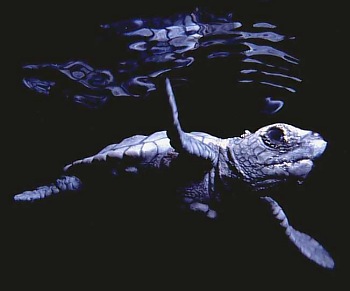
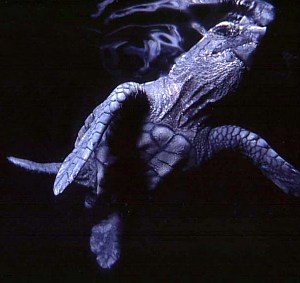
Dear Bill,
Following your comment about turtles eating pleurobranchs: Two turtle species can be seen around Turkish coasts, Caretta caretta and Chelonia mydas. The latter is a rare one but C. caretta [illustrated here] is common since Antalya is one of the breeding regions. If the P. testudinarius I have posted in my previous message had been eaten by a turtle, here is the photo of the suspect :)
Photos: A baby Caretta caretta
size: 9cm
Place: Tekirova, Antalya, Turkey
Date: 22/8/1998
Photo: Hasan Yokes: hyokes@turk.net
Best wishes
Baki
bakiyokes@turk.net
Yokes, B., 2002 (Jun 19) Re: Pleurobranchus testudinarius from Turkey. [Message in] Sea Slug Forum. Australian Museum, Sydney. Available from http://www.seaslugforum.net/find/7267Dear Baki,
I never expected baby photos! It would certainly be interesting to know if they showed any interest in pleurobranchs.
Cheers,
Bill Rudman
Re: Pleurobranchus from Turkey
June 15, 2002
From: Jim Anderson
Dear Dr. Rudman,
Regarding the recent posting from Baki Yokes.
My recent sighting in Scotland of P. membranaceus had many of the animals with similar looking damage as Baki's animal. The Scottish animals were generally spawning - could the loss of body material be connected? There are no turtles in Scotland other than the odd wandering Leatherback in summer, but certainly not at this time of the year.
Regards,
Jim A
jander4454@aol.com
Anderson, J., 2002 (Jun 15) Re: Pleurobranchus from Turkey. [Message in] Sea Slug Forum. Australian Museum, Sydney. Available from http://www.seaslugforum.net/find/7257Dear Jim,
Rather than implying that it was probably turtle damage I was trying to say that we know almost nothing about their predators except for one unpublished record of mine of turtles feasting on P. forskalii in Tanzania. I would assume they swallow them whole rather than nibble around the edges. Your suggestion about them being exhausted and 'spent' and at the end of their life cycle after breeding is an interesting thought. I can't imaging the tissue just rotting away around the edges if the animal is still alive, but perhaps they reach a stage when they don't produce or replenish the acid secretions they have in their mantle glands. This would leave them liable to attack from small fish and crustacea. It is certainly something which is worth following up.
Perhaps someone has noticed this previously? Any thoughts welcome.
Bill Rudman
Pleurobranchus testudinarius from Turkey
June 14, 2002
From: Baki Yokes
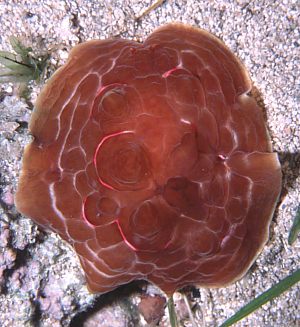
Dear Bill,
Here are some photos of Pleurobrancus testudinarius. One of the specimens we have encountered had been severely injured. It seems that there is something which likes the mantle of this slug. As it is seen in the photo, the edge of the mantle have been bitten. Do you have any suggestion about identity of the suspect, or do you have any idea about other possible causes?
Photos: Baki Yokes
Place: Antalya, Turkey
Dive site: Uc Adalar
Date: May 2002
Depth: 13m
Size: specimens 20cm, egg ribbon 15cm
Best wishes
Baki
bakiyokes@turk.net
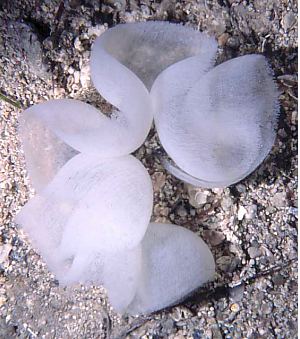
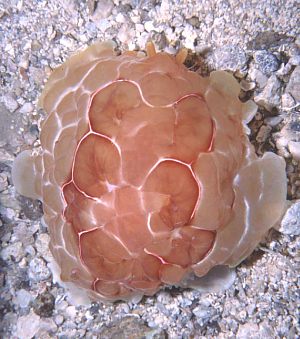
Thanks Baki,
We know too little about what eats opisthobranchs. Thankfully, some information is beginning to accumulate on the Predation Records page, but it is very slow. Like many opisthobranchs pleurobranchs have distasteful acid glands which no doubt are aimed at deterring predators but clearly some animals prefer a challenge. I wouldn't know if there are turtles in the Mediterranean. I certainly know of turtles having a meal of large Pleurobranchus forskalii in east Africa, but I wouldn't know if that is a relevant observation for Turkey.
Best wishes,
Bill Rudman
Pleurobranchus testudinarius? from Florida
June 3, 2000
From: Kenneth Nelson
There are two specimens of this particular sea slug at Ft. Pickens, Pensacola, Florida. I would like any information or where a good source of information about them. I have been diving this area for over twenty years and this is the first of their kind to be seen. This is both a commerical and military port and perhaps they hitched a ride on a ship. Please send me your views on this matter or is this just a natural event. Thank you
Kenneth Nelson
Mobile, Alabama
kennelsn47@aol.com
Nelson, K., 2000 (Jun 3) Pleurobranchus testudinarius? from Florida. [Message in] Sea Slug Forum. Australian Museum, Sydney. Available from http://www.seaslugforum.net/find/2493Dear Kenneth,
It would be very useful to have a photo of this animal to confirm your identification as Pleurobranchus testudinarius. This species is quite common in the Mediterranean, but to my knowledge the only record of it in the Western Atlantic is of one preserved animal from Maranhao in northern Brazil (Marcus, 1970).
If we can confirm your identification, then it is possibly a natural distribution as there are quite a number of opisthobranchs which are found on both sides of the Atlantic, though it is strange that such a big animal has not been reported before. With luck someone with knowledge of the Florida fauna will be able to give us further information.
Reference: Marcus, Ev. (1970) Opisthobranchs of Northern Brazil. Bulletin of Marine Science, 20(4): 922-951
Best wishes,
Bill Rudman.
Re: Pleurobranchus testudinarius
September 21, 1999
From: Juan Lucas Cervera
Dear Bill:
Erwin's photo is definitely Pleurobranchus testudinarius. This species has been also recorded in Atlantic Ocean (Azores and Canary Islands) (Wirtz, 1995). I think is easy to distinguish it from P. forskalii. The size of the tubercles of P. testudinarius are much bigger that those of P. forskalii. Moreover, in this last species there are several tubercles within each polygonal area, while in P. testudinarius there is only one. On the other hand, the biggest specimens of P. testudinarius may display an opaque white edge of the mantle.
It seems to me that the Mediterranean records of P. forskalii are from Israel.
Bill, is the species Pleurobranchus mamillatus only known from its original description or are there more descriptions or photos?
Regards.
Lucas.
lucas.cervera@uca.es
Cervera, J.L., 1999 (Sep 21) Re: Pleurobranchus testudinarius. [Message in] Sea Slug Forum. Australian Museum, Sydney. Available from http://www.seaslugforum.net/find/1356Thanks Lucas,
Concerning Pleurobranchus mamillatus. As I mention in Erwin's message, it has been reported infrequently from various parts of the Indo-West Pacific. I'll put it on my list of pages to prepare.
Bill Rudman.
Pleurobranchus testudinarius from Italy
September 19, 1999
From: Erwin Koehler
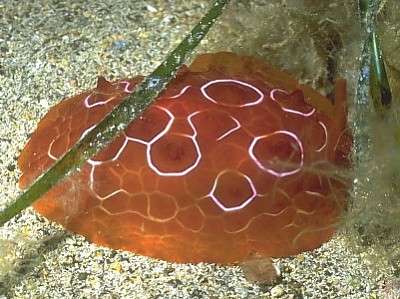
Bill,
This photo was taken by Wolfgang Seifarth this summer in Italy on a nightdive.
If someone said it would come from the Pacific I'd say it is
Pleurobranchus forskalii. This species lives in the Mediterranean also, but I have no idea how it looks like there. Or is it Pleurobranchus
testudinarius = (Susania testudinaria)? Or are both one species?
Erwin
Medslugs.Koehler@t-online.de
Koehler, E., 1999 (Sep 19) Pleurobranchus testudinarius from Italy. [Message in] Sea Slug Forum. Australian Museum, Sydney. Available from http://www.seaslugforum.net/find/1348The photo is of Pleurobranchus testudinarius which is known only from the Mediterranean. There is a very similar species, Pleurobranchus mamillatus Quoy & Gaimard, 1832, in the Indo-west Pacific. It was described from Mauritius, and is known from South Africa, eastern Australia and New Caledonia. It has the same colour pattern as Pleurobranchus testudinarius, even down to the pinkish rings, but seems to have longer dorsal papillae than the Mediterranean species.
It is interesting that you suggest a similarity with the Indo-West Pacific species Pleurobranchus forskalii. The earliest name for Pleurobranchus testudinarius was a name which had never been used - Pleurobranchus forskahli delle Chiaje, 1822. Some years ago I asked the International Commission on Zoological Nomenclature to suppress that name as it would mean replacing Pleurobranchus testudinarius and would also be very confusing to have it and P. forskalii in use for quite different species, especially since P. forskalii seems to have recently made it into the Mediterranean through the Suez Canal.
Bill Rudman.
